Oecophylla longinoda sensu strictu (Latreille)
  Type location Senegal (Formica
longinoda, Latreille, 1802c, worker; minor described as Oecophylla
brevinodis nov sp, André, 1890: 313) - no images on Antweb (October 2014), brevinodis see below Type location Senegal (Formica
longinoda, Latreille, 1802c, worker; minor described as Oecophylla
brevinodis nov sp, André, 1890: 313) - no images on Antweb (October 2014), brevinodis see below  . .
|
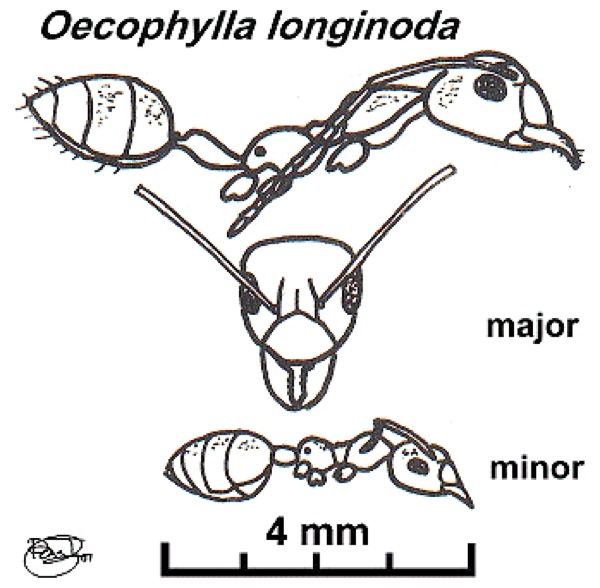 The original
description by Latreille (1802c) is
at The original
description by Latreille (1802c) is
at  . .
My translation) is -
"The long-node ant (la Fourmi long-noeud). Formica
longinoda
Rust-coloured, elongated; long antenna, with the first segment red;
head large; petiole scale long, gaster small.
Rufescens elongata; antennis longis, primo articulo
rufo; capite magno; squam elongata; abdomine parvo.
TL 0.007 m - she is rust-red or pale chestnut, almost glabrous,
elongated. The antennae are long, of a redddish-yellow, with the first
joint of a brighter colour. The head is large, wider than the alitrunk
("corcelet"), almost heart-shaped, convex and rounded posteriorly. The
anterior (clypeus) without carinae, and the frontal area with a feeble
notch. The mandibles are strong, triangular, concolorous with the body,
meeting against each other on the interior border, hooked, with the
apices crossing. The eyes are quite large and blackish. The alitrunk is
raised, and rounded anteriorly, narrowed in its middle, behind with
inequalities in its narrowing; the posterior extremity also is a little
raised, rounded and finishing with a slope. The (petiole) scale is
cuneiform and elongated towards the apex; there is a quite large gap
between the scale and the gaster, which is small and near round. The
legs are long, pale yellowish-red.
This species lives in Senegal. Specimen in the national Museum of
Natural History".
|
Bolton (1995: 298) shows longinoda as reduced to
a junior synonym of virescens (i.e. smaragdina) by F
Smith (1858b: 29) but resurrected to species by Dalla Torre (1893:
176). Dalla Torre's contribution was solely to catalogue species and
there was no argued knowledge. Dalla Torre cited "Oecophylla
longinoda Gerstaecker, v.d.Deceken: Ost-Afrika. Gliedertheiere,
1873, p. 343, n.44". An alternative and earlier reference is
Gerstaecker (1871: 354), nominally reporting insects from Zanzibar (as
then understood), which include - "Oecophylla longinoda Latr.,
Hist. nat. d. Fourm. p. 184, pl.XI, fig. 72 (= Form virescens
Smith, pars). Von Mombas". Looking at F Smith (1860b: 101), where he
wrote on the genus Oecophylla, it appears he had seen only
specimens from South Africa. It seems possible that the specimens were
of Oecophylla
textor, which I suggest as probably a distinct species closer
to smaragdina than to the type longinoda].
Andre's (1890) description of the minor worker, thinking
it was a distinct species, Oecophylla brevinodis, from among
the major workers of "Oecophylla smaragdina" from Sierra Leone,
is at  . .
Emery's (1892d) note, including the queen, linking the
minor and major workers, and remarks on the Esat African form as nearer
smaragdina, is at  . .
|
 Wheeler
(1922) gave
rather a vague description of the typical form. He wrote of differences
from smaragdina but one can extract - Wheeler
(1922) gave
rather a vague description of the typical form. He wrote of differences
from smaragdina but one can extract -
The integument is more decidedly opaque; the
mandibles are somewhat more coarsely striated, always darker, being
concolorous with the posterior portion of the head, at least in the
large workers, and especially in the dark varieties. As to the female
the wing veins are heavily bordered with dark brown; and the bases of
the second and following gastric segments are broader, darker and more
sharply marked off; the green portions of the typical female are more
olivaceous and less pea-green; and the basal bands of the gaster are
more exposed and brownish; the appendages are more brownish. The male
(TL 6-6.5 mm) is darker and more blackish. The workers he separated by
a
key [see hs text, link below].
Thus, the typical worker is the ferruginous
(rust-coloured) form. On size variation Wheeler is somewhat vague,
writing - "In the worker the polymorphism is greater [than smaragdina],
for not only do the individuals of the same colony show a greater range
in size (from 3 to 9 mm) but the minimae differ more from the mediae
and maximae in the shape of the thorax and petiole".
Wheeler's full commentary (1922: 224-231) can be seen at  . .
|
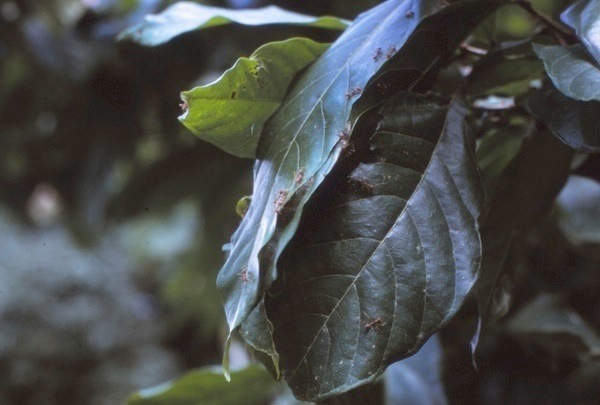 In Nigeria the
only form I ever saw was of what I take as the typical variety; these
are shown in my drawing (above) and the enlargement of my photograph of
a nest
in a cocoa tree. In Nigeria the
only form I ever saw was of what I take as the typical variety; these
are shown in my drawing (above) and the enlargement of my photograph of
a nest
in a cocoa tree.
DESCRIPTION - (type form, CRIN Nigeria, Taylor, 1978:
33) dimorphic, with a subsidiary polymorphy within the major form of,
at least, some varieties.
Major worker - TL 8.04 mm, HL 1.71, HW 1.62, SL 2.49, PW 0.93
Minor worker - TL 4.56 mm, HL 1.09, HW 1.06, SL 0.96, PW 0.59
Gotwald (1973) examined the mouthparts of major workers
from Ghana, see  . The general features of the head
mouthparts in his illustrations (Fig. 1 & 5) match those of what I
regard as the type form. . The general features of the head
mouthparts in his illustrations (Fig. 1 & 5) match those of what I
regard as the type form.
|
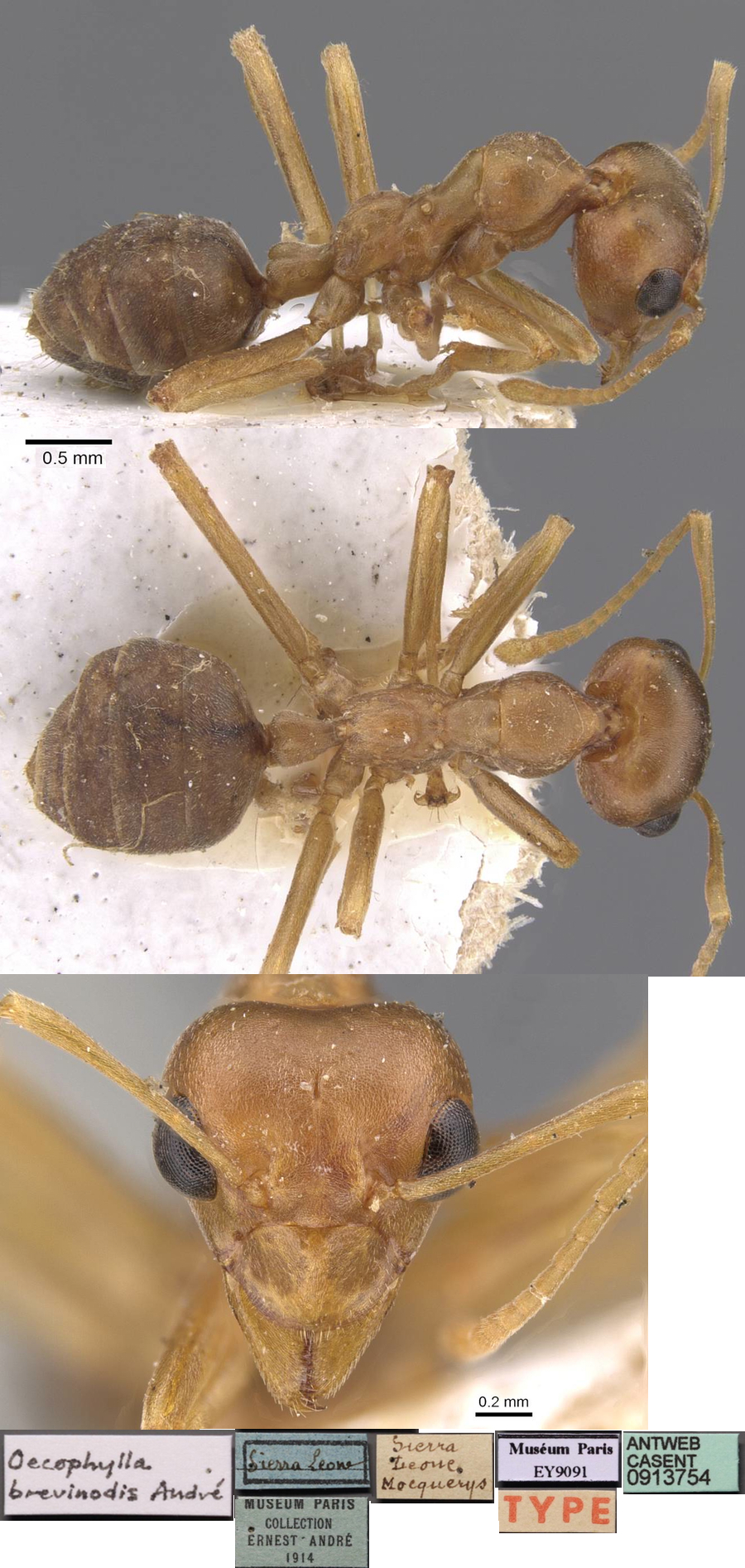 The photomontage of a
brevinodis type (minor) worker is collated
from http://www.antweb.org/specimenImages.do?code=casent0913754. The photomontage of a
brevinodis type (minor) worker is collated
from http://www.antweb.org/specimenImages.do?code=casent0913754.
|
Oxford
University Museum
specimens
|
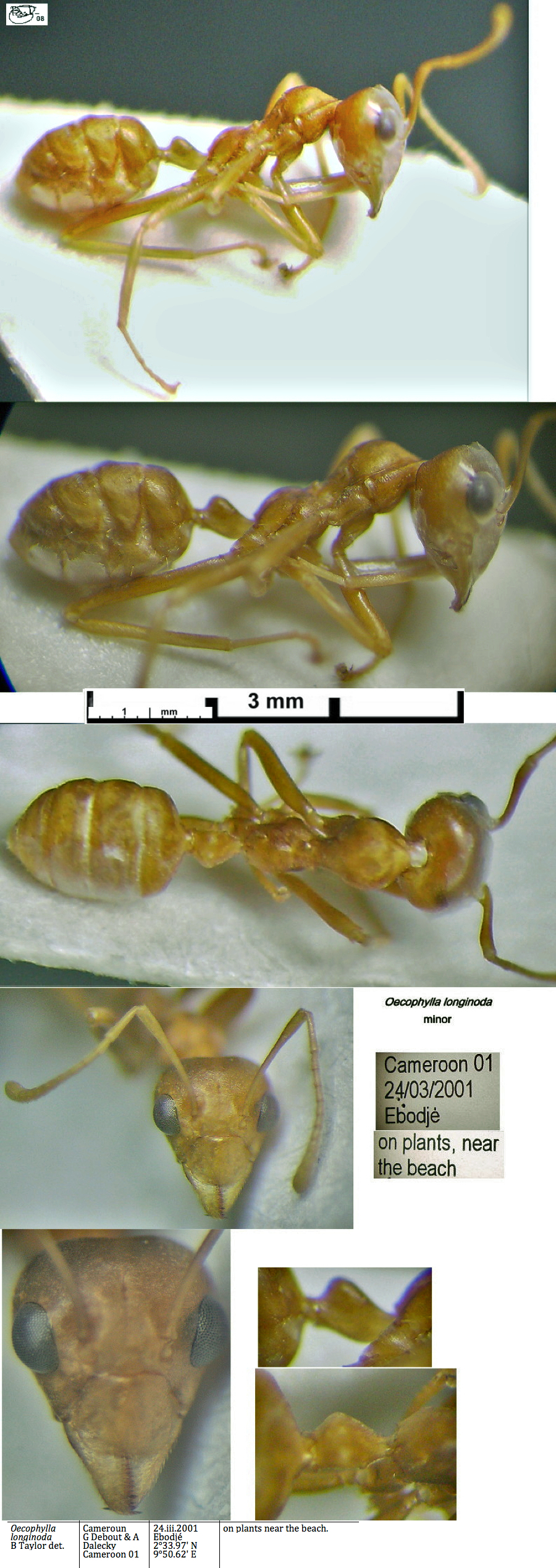 MINIMA -
The photomontages are of workers
collected in Cameroun - south-western tropical coastal forest
area between Edéa and Campo (McKey Wolbachia project, Cameroon
01). MINIMA -
The photomontages are of workers
collected in Cameroun - south-western tropical coastal forest
area between Edéa and Campo (McKey Wolbachia project, Cameroon
01).
Note
the close-up of the head surface texture which has no sculpturation
other than the fine micro-reticulation, whereas the possible claridens
(Cameroon 56) has distinct but scattered shallow pits.
|
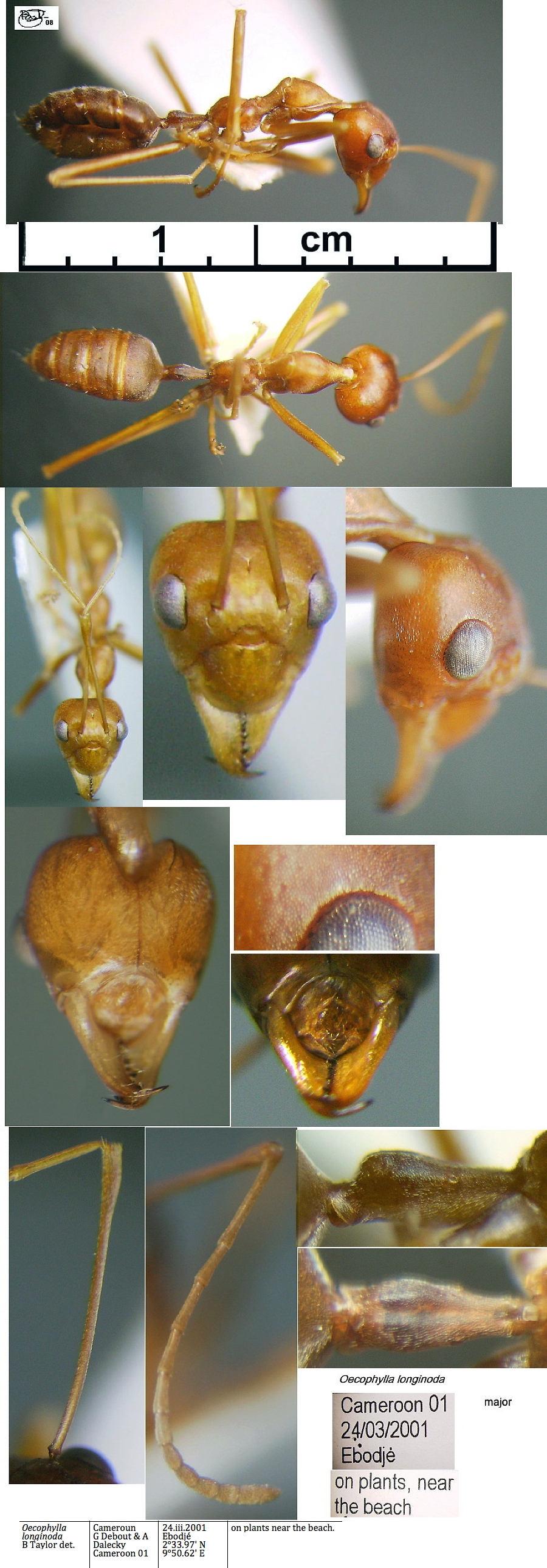 MAJOR MAJOR
|
 The
photomontage is of a major worker from the Central
African Republic, Dzanga-Sangha NP; collector Philippe
Annoyer (CAR DF). The
photomontage is of a major worker from the Central
African Republic, Dzanga-Sangha NP; collector Philippe
Annoyer (CAR DF).
|
 The
photomontage is of a queen from Liberia, Yekepa Camp 4;
collector E Poiriet (CAR DF). The
photomontage is of a queen from Liberia, Yekepa Camp 4;
collector E Poiriet (CAR DF).
|
 The
photomontage is of a male from Benin, Koro;
collector J-F Vayssieres (RVA 3040). The
photomontage is of a male from Benin, Koro;
collector J-F Vayssieres (RVA 3040).
|
|